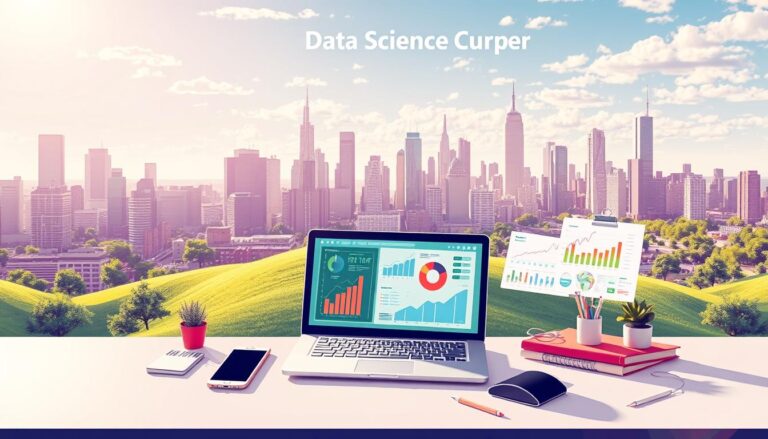Mastering Machine Learning: Insights for Success
In today’s fast-paced world, machine learning has become a cornerstone of innovation. From personalized recommendations to advanced medical diagnostics, its applications are reshaping industries. But what makes it so powerful? At its core, it’s about using algorithms to analyze data and uncover patterns that drive smarter decisions.
This guide is designed to help you understand the fundamentals and practical steps to mastering this transformative technology. Whether you’re a beginner or looking to refine your skills, we’ll explore how data, models, and algorithms work together to deliver intelligent outcomes. You’ll also discover the differences between traditional methods and advanced techniques like deep learning.
By leveraging artificial intelligence, businesses can make better decisions, innovate strategically, and stay ahead in competitive markets. Ready to dive in? Let’s explore how you can harness the power of machine learning to achieve success.
Key Takeaways
- Machine learning is transforming industries through data-driven insights.
- Algorithms and models are the backbone of intelligent decision-making.
- Deep learning offers advanced capabilities for complex tasks.
- Understanding data is crucial for effective machine learning applications.
- Leveraging AI can lead to strategic innovation and competitive advantage.
Introduction to the How-To Guide on Machine Learning
Unlocking the potential of intelligent systems begins with a solid foundation. This guide is designed to help you navigate the essentials, whether you’re just starting or looking to refine your skills. We’ll walk you through the key steps to build a strong understanding of the process, from data preparation to model deployment.
Understanding the importance of training and feature selection is crucial. These elements help computers recognize patterns in data, whether labeled or unlabeled. Over time, models improve their accuracy, making them powerful tools for decision-making.
This guide will introduce you to the core concepts, including data preparation, algorithm design, and model evaluation. You’ll learn how to select the right features and optimize training processes to create robust models. By combining theory with practical applications, you’ll gain the skills needed to tackle real-world challenges.
Whether you’re a professional aiming to stay ahead or a curious learner, this guide offers actionable insights. Let’s dive in and explore how you can harness the power of intelligent systems to achieve your goals.
Understanding Machine Learning Fundamentals
At the heart of intelligent systems lies the ability to process and interpret datum effectively. These systems rely on recognizing patterns in data to make informed decisions. Whether it’s predicting outcomes or identifying trends, the foundation is built on how data is analyzed and utilized.
Key concepts like features and labels play a crucial role. Features are the individual measurable properties of the datum, while labels are the outcomes you want to predict. Together, they help models learn and improve over time.
The sheer amount and variety of datum significantly impact model performance. More data often leads to better accuracy, but the quality and relevance of the input are equally important. Clean, well-organized data ensures models can learn effectively.
Different types of data—such as numerical, categorical, or text—require unique approaches during training. For example, numerical data might be scaled, while text data needs to be tokenized. Understanding these differences is essential for building robust models.
Patterns in datasets are what models aim to recognize. For instance, in a sales dataset, a model might identify that higher advertising budgets lead to increased sales. By analyzing these patterns, models can make accurate predictions and provide valuable insights.
Key Components of a Machine Learning Model
Building a robust system starts with understanding its core components. A model is the backbone of any intelligent system, designed to process data and make informed decisions. To truly grasp how it works, we need to break down its internal structure and mechanics.
Decision Process and Prediction Mechanics
At its core, a model relies on a decision process to analyze input data and generate predictions. For example, IBM’s systems use algorithms to evaluate patterns in data, such as identifying trends in sales or customer behavior. This process involves weighing different factors to arrive at the most accurate outcome.
Think of it like a flowchart. Each step in the process guides the model toward a specific decision. The more refined the process, the better the prediction accuracy. This iterative approach ensures the system learns and improves over time.
Error Function and Model Optimization Process
No model is perfect, and that’s where the error function comes in. This function measures the difference between the predicted outcome and the actual result. By quantifying these discrepancies, the system can identify areas for improvement.
Optimization is the next step. Techniques like gradient descent adjust the model’s parameters to minimize error. For instance, IBM’s optimization methods fine-tune weights in neural networks to enhance performance. This iterative process ensures the model becomes more accurate with each adjustment.
Real-world applications, such as fraud detection or personalized recommendations, rely on this continuous refinement. By understanding these components, you can build systems that deliver reliable and actionable insights.
Exploring Various Types of Learning Approaches
Understanding the different ways systems learn is key to unlocking their full potential. Each approach—supervised, unsupervised, reinforcement, and semi-supervised—has unique strengths and applications. Let’s dive into how these methods work and where they excel.
Supervised Learning and Regression Techniques
Supervised learning relies on labeled data to train a learning model. The algorithm maps inputs to outputs, making it ideal for tasks like predicting house prices or classifying emails. For example, in healthcare, it can diagnose diseases based on patient data.
Regression techniques, a subset of supervised learning, predict continuous outcomes. Think of forecasting sales or estimating weather patterns. These methods are powerful because they learn from past data to make accurate predictions.
Unsupervised Learning and Clustering Methods
Unsupervised learning works with unlabeled data, uncovering hidden patterns. Clustering is a common technique, grouping similar data points together. Retailers use it for customer segmentation, identifying groups with similar buying habits.
This approach is valuable when labeled data is scarce or expensive. It’s also great for anomaly detection, like spotting fraudulent transactions in financial data.
Reinforcement and Semi-Supervised Learning
Reinforcement learning is all about trial and error. The algorithm learns by receiving rewards or penalties for its actions. Self-driving cars use this method to navigate roads safely.
Semi-supervised learning combines labeled and unlabeled data. It’s useful when labeling data is time-consuming. For instance, it’s applied in medical imaging to improve diagnostic accuracy with limited labeled samples.
| Approach | Data Type | Key Applications |
|---|---|---|
| Supervised | Labeled | Predictive analytics, classification |
| Unsupervised | Unlabeled | Clustering, anomaly detection |
| Reinforcement | Interactive | Autonomous systems, game playing |
| Semi-Supervised | Mixed | Medical imaging, NLP |
Each learning algorithm has its place, depending on the problem you’re solving. By understanding these approaches, you can choose the right tool for your needs and achieve better results.
Deep Learning vs. Classical Machine Learning
When it comes to advanced data analysis, the distinction between deep learning and classical methods is crucial. While both aim to extract insights from data, their approaches and capabilities differ significantly. Understanding these differences can help you choose the right tool for your specific needs.
Neural Networks and Layered Architectures
Deep learning relies on artificial neural networks (ANNs), which mimic the human brain’s structure. These networks consist of multiple layers, each designed to process specific aspects of the data. For example, in image recognition, the first layer might detect edges, while deeper layers identify complex patterns like shapes or objects.
This layered architecture allows deep learning models to automatically extract features from unstructured data. Unlike classical methods, which require manual feature engineering, deep learning reduces human intervention, making it more efficient for complex tasks.
Differences in Data Handling and Feature Extraction
Classical methods often rely on structured data and human-guided feature selection. For instance, in spam detection, engineers manually define features like keywords or sender addresses. While effective for simpler tasks, this approach struggles with unstructured data like images or audio.
In contrast, deep learning excels in handling unstructured data. Its ability to autonomously extract features makes it ideal for tasks like medical image analysis, where it can identify abnormalities invisible to the human eye. This autonomy, however, comes with higher computational costs and the need for vast datasets.
Here’s a quick comparison:
- Deep learning: Best for complex tasks, unstructured data, and automatic feature extraction.
- Classical methods: Suitable for simpler tasks, structured data, and manual feature engineering.
By understanding these nuances, you can leverage the strengths of each approach to achieve superior results in your data analysis projects.
Essential Algorithms in Machine Learning
The backbone of intelligent decision-making lies in the algorithms that power it. These tools are the foundation of predictive analytics, transforming raw data into actionable insights. Whether you’re forecasting sales or classifying images, the right algorithm can make all the difference.
Let’s explore some of the most widely used algorithms and their real-world applications. From linear regression to ensemble methods, each has unique strengths and limitations. Understanding these will help you choose the best tool for your specific needs.
Linear Regression, Decision Trees, and SVM
Linear regression is a simple yet powerful algorithm for predicting continuous outcomes. It’s commonly used in finance to forecast stock prices or in marketing to analyze customer behavior. The output is a straight line that best fits the data, making it easy to interpret.
Decision trees are versatile and intuitive. They split data into branches based on feature values, making them ideal for both classification and regression tasks. For example, they’re used in healthcare to diagnose diseases based on patient symptoms.
Support Vector Machines (SVM) excel in high-dimensional spaces. They’re robust for tasks like image classification or text categorization. By maximizing the margin between classes, SVMs deliver accurate results even with complex datasets.
Random Forests, Boosting, and Ensemble Methods
Random forests combine multiple decision trees to improve accuracy and reduce overfitting. They’re widely used in e-commerce for product recommendations or in finance for credit scoring. Each tree votes on the final output, ensuring a balanced decision.
Boosting methods like Gradient Boosting and AdaBoost build models sequentially to correct errors from previous iterations. They’re highly effective in competitions like Kaggle, where precision is key. These algorithms are perfect for tasks requiring high accuracy.
Ensemble methods leverage the strengths of multiple algorithms to produce superior results. By combining models, they mitigate individual weaknesses and enhance overall performance. This approach is ideal for complex problems where no single algorithm suffices.
Choosing the right algorithm depends on your data and the desired output. While linear regression is great for simple predictions, ensemble methods shine in complex scenarios. By understanding these tools, you can unlock the full potential of your data and drive smarter decisions.
Building and Training Your Learning Model
The journey to a high-performing model begins with clean data and thoughtful feature engineering. These steps are critical to ensure your system can learn effectively and deliver accurate results. Let’s break down the process into actionable steps you can follow.
Data Preparation and Feature Engineering
Start by cleaning your dataset. Remove duplicates, handle missing values, and ensure consistency. This step ensures your model has high-quality input to work with. Next, focus on feature engineering. This involves selecting and transforming variables that best represent the problem you’re solving.
For example, if you’re predicting house prices, relevant features might include square footage, location, and the number of bedrooms. Use techniques like scaling or encoding to make your data more usable. Remember, the quality of your features directly impacts your model’s performance.
Model Training and Tuning for Accuracy
Once your data is ready, split it into training, validation, and testing sets. The training set teaches your model, while the validation set helps you fine-tune it. The testing set evaluates its final performance. This approach prevents overfitting and ensures your model generalizes well to new data.
During training, monitor metrics like accuracy and loss. Use techniques like cross-validation to assess performance consistently. If your model isn’t performing well, adjust hyperparameters like learning rate or batch size. Tools like grid search or Bayesian optimization can help you find the best settings efficiently.
Here are some actionable tips to improve your model’s performance:
- Use early stopping to prevent overfitting.
- Experiment with different algorithms to find the best fit.
- Regularly update your model with new data to maintain accuracy.
By following these steps, you’ll build a robust system that delivers reliable insights. Remember, the key to success lies in continuous refinement and attention to detail.
Navigating the Machine Learning Pipeline and Workflow
To master intelligent systems, understanding the workflow is essential. The pipeline is a structured process that transforms raw data into actionable insights. From data acquisition to deployment, each step plays a critical role in ensuring the system performs efficiently.
Data Cleaning and Feature Scaling
Data cleaning is the first task in the pipeline. It involves removing errors, handling missing values, and eliminating outliers. Clean data ensures the system can learn effectively and produce accurate results. For example, in healthcare, cleaning patient records can improve diagnostic accuracy.
Feature scaling is another crucial step. It standardizes data to ensure all variables contribute equally to the model. Techniques like normalization or standardization are commonly used. Proper scaling enhances the system’s performance, especially in algorithms sensitive to data ranges.
Common Tasks and Problems in the Workflow
Every workflow has its challenges. One common problem is data imbalance, where one class dominates the dataset. This can skew results and reduce accuracy. Another issue is overfitting, where the model performs well on training data but poorly on new data.
To address these problems, techniques like cross-validation and regularization are used. Cross-validation ensures the model generalizes well, while regularization prevents overfitting. These steps are vital for building a robust system.
Roadmap for Managing an Efficient System
Managing a scalable system requires a clear roadmap. Here’s a step-by-step guide:
- Data Acquisition: Collect high-quality data from reliable sources.
- Preprocessing: Clean and scale data to prepare it for modeling.
- Model Training: Use algorithms to train the model on prepared data.
- Evaluation: Test the model’s performance using validation and test sets.
- Deployment: Integrate the model into real-world applications.
By following this roadmap, you can streamline the workflow and ensure the system delivers consistent results. Remember, each step is interconnected, and attention to detail is key to success.
Deploying Your Machine Learning Model with MLOps

Bringing your model to life requires more than just development—it’s about seamless integration. This is where MLOps comes in. It bridges the gap between creating a model and making it work in real-world scenarios. By combining development and operations, MLOps ensures your system delivers consistent value.
MLOps Best Practices for Seamless Integration
To achieve smooth integration, start with automation. Automating tasks like data validation and model training reduces errors and speeds up the process. For example, CI/CD pipelines ensure every update is tested and deployed efficiently.
Another key practice is tracking. Keep detailed records of your model’s training data, hyperparameters, and performance metrics. This approach makes it easier to troubleshoot issues and reproduce results.
“MLOps isn’t just about tools—it’s about creating a culture of collaboration between teams.”
Deployment Strategies and Ongoing Monitoring
Choosing the right deployment strategy is crucial. Here are three common approaches:
| Strategy | Description | Best Use Case |
|---|---|---|
| Continuous Integration | Automates testing and deployment of small updates. | Frequent model updates |
| Canary Deployment | Rolls out changes to a small group first. | Risk-sensitive environments |
| Blue-Green Deployment | Switches between two identical environments. | Zero-downtime updates |
Once deployed, ongoing monitoring is essential. Track performance metrics and watch for data drift. This ensures your model stays accurate and reliable over time.
Here are some tips to optimize your deployment process:
- Use feature stores to centralize and reuse data.
- Set up automated retraining pipelines for fresh data.
- Log predictions for traceability and compliance.
By following these steps, you’ll create a robust system that delivers sustained value and support for your business needs.
Enhancing System Performance and Optimization
Optimizing system performance is a continuous journey that demands attention to detail and strategic planning. Whether you’re improving speed, accuracy, or efficiency, the right techniques can make all the difference. Let’s explore how you can fine-tune your system and implement real-world strategies for better results.
Performance Tuning Techniques
To get the most out of your system, start by monitoring key performance indicators (KPIs). These metrics help you identify bottlenecks and areas for improvement. For example, tracking latency and accuracy ensures your system meets operational requirements.
Iterative testing is another powerful way to refine performance. By running frequent experiments, you can collect data and make informed adjustments. This approach is especially useful when deploying updates or new features.
Here are some actionable tips for performance tuning:
- Use automated tools to streamline data validation and model training.
- Regularly update your system with fresh data to maintain accuracy.
- Optimize infrastructure at the compute, storage, and network layers.
Real-World Optimization Strategies
Leading organizations often rely on customer feedback to drive performance improvements. For instance, analyzing user behavior can reveal pain points and opportunities for enhancement. This person-centric approach ensures your system meets real-world needs.
Another effective strategy is leveraging pre-trained models. These models can save time and resources while delivering high-quality results. However, it’s essential to evaluate whether building, tuning, or using these models aligns with your goals.
Here’s how you can implement real-world optimization:
- Use feature stores to centralize and reuse data efficiently.
- Set up automated retraining pipelines to keep your system up-to-date.
- Monitor for data drift to ensure consistent performance over time.
By combining these techniques, you can create a system that not only performs well but also adapts to changing demands. Remember, optimization is an ongoing process—stay proactive and keep refining your approach.
Integrating AI Ethics and Data Privacy in Machine Learning
Balancing innovation with responsibility is critical in today’s tech-driven world. As intelligent systems become more integrated into our lives, ethical considerations and data privacy take center stage. Ensuring fairness, transparency, and compliance isn’t just a legal obligation—it’s a moral imperative.
Addressing Bias and Discrimination
Bias in training data can lead to unfair outcomes, perpetuating discrimination. For example, a hiring algorithm might favor certain demographics if the training data is skewed. To mitigate this, organizations must audit datasets for biases and ensure diverse representation.
Regular audits and stakeholder consultations are essential. By involving diverse perspectives, companies can identify and address ethical pitfalls early. This proactive approach fosters trust and ensures fairer outcomes.
Ensuring Data Protection and Transparency
Data privacy is a cornerstone of ethical AI. Regulations like GDPR and CCPA set strict guidelines for data handling. Companies must implement robust measures, such as anonymization and encryption, to protect user information.
Transparency is equally important. Users should understand how their data is used and have control over it. For example, clear consent forms and opt-out options empower individuals to make informed decisions.
Here are some best practices for ethical AI:
- Conduct regular audits to identify and address biases.
- Implement anonymization techniques to protect user privacy.
- Ensure compliance with data protection regulations like GDPR and CCPA.
- Foster transparency through clear communication and user-friendly interfaces.
By adopting these practices, organizations can build systems that are not only powerful but also ethical and trustworthy. The future of technology depends on our ability to balance innovation with responsibility.
Overcoming Data Challenges in Real-World Applications
Data challenges are a common hurdle in real-world applications, but they’re not insurmountable. From incomplete datasets to noisy input, these issues can hinder performance. However, with the right strategies, you can turn these obstacles into opportunities for innovation.
One of the most common problems is missing or incomplete datum. This can skew results and reduce the accuracy of your models. To address this, consider techniques like imputation or synthetic data generation. For example, Generative Adversarial Networks (GANs) can create realistic data to fill gaps.
Another challenge is data imbalance, where one class dominates the dataset. This is especially problematic in predictive maintenance, where failure instances are rare. To tackle this, you can use techniques like oversampling or creating failure horizons to balance the dataset.
Understanding underlying patterns is crucial for solving these issues. By analyzing trends and correlations, you can identify areas for improvement. For instance, in healthcare, recognizing patterns in patient data can lead to better diagnostic tools.
Here’s a quick guide to overcoming common data challenges:
| Challenge | Solution |
|---|---|
| Missing Data | Use imputation or synthetic data generation. |
| Data Imbalance | Apply oversampling or failure horizons. |
| Noisy Data | Clean and preprocess data to remove outliers. |
| Large Datasets | Leverage distributed computing or feature selection. |
By addressing these challenges, you can ensure your models are robust and reliable. Remember, the key to success lies in continuous refinement and attention to detail.
Applying Machine Learning Across Industries
Across industries, innovative solutions are transforming how businesses operate. From healthcare to retail and transportation, these tools are driving efficiency, accuracy, and growth. Let’s explore how they’re making a difference in real-world scenarios.
Revolutionizing Healthcare with Advanced Tools
In healthcare, these technologies are saving lives and improving patient outcomes. For example, medical imaging systems now use algorithms to detect diseases like cancer with greater accuracy. This application reduces diagnostic errors and speeds up treatment.
Another example is predictive analytics. Hospitals use these tools to forecast patient admissions, ensuring they have the right resources available. This proactive approach improves efficiency and reduces wait times.
Enhancing Retail Experiences Through Personalization
Retailers are leveraging these tools to create personalized shopping experiences. For example, online platforms analyze customer behavior to recommend products tailored to individual preferences. This application boosts sales and enhances customer satisfaction.
Inventory management is another area benefiting from these technologies. Retailers use predictive analytics to optimize stock levels, reducing waste and ensuring popular items are always available.
Driving Innovation in Autonomous Vehicles
Autonomous vehicles rely heavily on these technologies for safety and efficiency. For example, algorithms process real-time data from sensors to navigate roads and avoid obstacles. This application is paving the way for safer, more efficient transportation systems.
Another example is route optimization. Logistics companies use these tools to plan the most efficient delivery routes, saving time and fuel. This not only reduces costs but also minimizes environmental impact.
| Industry | Application | Impact |
|---|---|---|
| Healthcare | Medical Imaging | Improved diagnostic accuracy |
| Retail | Personalized Recommendations | Increased sales and customer satisfaction |
| Transportation | Autonomous Navigation | Safer, more efficient travel |
These examples illustrate the transformative power of modern technologies across industries. By adopting these tools, businesses can stay competitive and drive innovation in their fields.
Effective Machine Learning Strategies for Accurate Predictions
Accurate predictions are the cornerstone of successful decision-making in any field. Whether you’re forecasting sales or identifying trends, the right strategies can significantly enhance your accuracy. Let’s explore how you can design and refine models to achieve reliable outcomes.
Start with clean, well-prepared data. Poorly prepared data can lead to overfitting, where models perform well on training data but poorly on unseen data. Techniques like imputation and feature scaling ensure your data is ready for analysis. For example, normalization standardizes variables, making them easier for models to process.
Iterative testing is another critical step. By running frequent experiments, you can validate your predictions and identify areas for improvement. Cross-validation ensures your model generalizes well, while regularization prevents overfitting. These methods help maintain high accuracy over time.
Aligning your model’s decisions with business objectives is equally important. For instance, in retail, predictive analytics can optimize inventory levels, reducing waste and ensuring popular items are always available. This alignment ensures your predictions deliver tangible value.
Here are some actionable tips to enhance your prediction strategies:
- Use automated tools to streamline data validation and model training.
- Regularly update your model with fresh data to maintain accuracy.
- Monitor performance metrics to identify and address issues early.
Here’s a quick comparison of key strategies:
| Strategy | Description | Impact |
|---|---|---|
| Data Preparation | Clean and scale data for analysis. | Improves model performance. |
| Iterative Testing | Run frequent experiments to validate predictions. | Ensures reliability over time. |
| Business Alignment | Align model decisions with objectives. | Delivers tangible value. |
By following these strategies, you can create models that not only make accurate predictions but also drive meaningful decisions. Remember, the key to success lies in continuous refinement and attention to detail.
Future Trends and Innovations in Machine Learning

The future of intelligent systems is brimming with possibilities, reshaping industries and daily life. From advancements in deep learning to the rise of ethical AI, the landscape is evolving rapidly. Staying ahead means understanding these trends and their potential impact.
Emerging Technologies and Applications
Next-generation deep learning architectures are pushing boundaries. For example, quantum computing is reducing execution times for complex tasks, making high-dimensional vector processing more efficient. This opens doors for faster, more accurate models.
Edge computing is another game-changer. By optimizing data transfer, it reduces latency and bandwidth use. This is critical for real-time analysis in industries like healthcare and autonomous vehicles. Wearable devices now provide real-time health insights, enabling early interventions.
Here’s a snapshot of emerging technologies:
| Technology | Application |
|---|---|
| Quantum Computing | High-speed data processing |
| Edge Computing | Real-time analysis in healthcare and transportation |
| Generative Models | Creating realistic data for training |
Ethical and Societal Impacts
As technology advances, ethical considerations become paramount. Bias in learning algorithms can lead to unfair outcomes, especially in sensitive areas like hiring or healthcare. Regular audits and diverse datasets are essential to mitigate these risks.
Transparency and data privacy are equally important. Regulations like GDPR ensure user data is protected, but organizations must go further. Clear communication about how data is used builds trust and empowers users.
Here are some key ethical practices:
- Conduct regular audits to identify and address biases.
- Implement anonymization techniques to protect user privacy.
- Ensure compliance with data protection regulations.
The future of machine learning models is bright, but it comes with responsibilities. By embracing innovation while addressing ethical concerns, we can create systems that deliver value and drive positive change. Stay informed, adapt, and be part of this transformative journey.
Conclusion
Mastering the art of intelligent systems begins with understanding the essentials. Throughout this guide, we’ve explored the core components—training, feature engineering, and model optimization—that form the backbone of effective algorithm design. These elements, combined with a strong foundation in artificial intelligence, empower you to tackle real-world challenges with confidence.
Applying this knowledge in your projects is key. Whether you’re refining a model or selecting the right algorithm, thoughtful execution ensures success. Remember, ethical considerations are just as important as technical expertise. A responsible approach builds trust and drives meaningful impact.
Your journey doesn’t end here. Continuous learning and practical application will keep you ahead in this ever-evolving field. Embrace the opportunities ahead, and let your expertise shape the future of intelligent systems.
FAQ
What is the difference between deep learning and classical machine learning?
How do supervised and unsupervised learning differ?
What are the key steps in building a machine learning model?
Why is data cleaning important in the machine learning pipeline?
What are some common algorithms used in machine learning?
How does reinforcement learning work?
What role does feature engineering play in model performance?
How can bias be addressed in machine learning models?
What industries benefit most from machine learning applications?
What are the emerging trends in machine learning?
Source Links
- Six Steps to Master To Become a Successful Machine Learning Engineer – Spiceworks – https://www.spiceworks.com/tech/artificial-intelligence/articles/best-resources-to-learn-ml/
- Mastering Machine Learning: The Path to Certification Success | Bespoke Training – https://www.bespoketraining.com/blog/mastering-machine-learning-the-path-to-certification-success/
- Mastering Machine Learning: Unlocking the Potential of Advanced Algorithms for Enhanced Performance | Institute of Data – https://www.institutedata.com/us/blog/mastering-machine-learning-unlocking-the-potential-of-advanced-algorithms-for-enhanced-performance/
- The Complete Beginner’s Guide to Machine Learning – https://www.akkio.com/beginners-guide-to-machine-learning
- Machine Learning Tutorial – GeeksforGeeks – https://www.geeksforgeeks.org/machine-learning/
- Machine Learning | Google for Developers – https://developers.google.com/machine-learning/crash-course
- ML Models: Understanding the Fundamentals – https://gretel.ai/blog/machine-learning-models
- Understanding Machine Learning – https://www.cambridge.org/core/books/understanding-machine-learning/3059695661405D25673058E43C8BE2A6
- Machine Learning Basics: Components, Application, Resources and More – https://blog.quantinsti.com/machine-learning-basics/
- What Is Machine Learning (ML)? | IBM – https://www.ibm.com/think/topics/machine-learning
- What are Machine Learning Models? – https://www.databricks.com/glossary/machine-learning-models
- Types of Machine Learning – GeeksforGeeks – https://www.geeksforgeeks.org/types-of-machine-learning/
- Different Types of Machine Learning: Exploring AI’s Core – https://www.simplilearn.com/tutorials/machine-learning-tutorial/types-of-machine-learning
- 3 Types of Machine Learning You Should Know – https://www.coursera.org/articles/types-of-machine-learning
- Deep Learning vs. Machine Learning – What’s The Difference? – https://levity.ai/blog/difference-machine-learning-deep-learning
- Deep Learning vs Machine Learning – Difference Between Data Technologies – AWS – https://aws.amazon.com/compare/the-difference-between-machine-learning-and-deep-learning/
- The Machine Learning Algorithms List: Types and Use Cases – https://www.simplilearn.com/10-algorithms-machine-learning-engineers-need-to-know-article
- Top 10 Machine Learning Algorithms You Must Know – https://www.analyticsvidhya.com/blog/2017/09/common-machine-learning-algorithms/
- Machine Learning Algorithms – GeeksforGeeks – https://www.geeksforgeeks.org/machine-learning-algorithms/
- How to Build a Machine Learning Model – Take Control of ML and AI Complexity – https://www.seldon.io/how-to-build-a-machine-learning-model
- Step 4: Build, Train, and Evaluate Your Model | Machine Learning | Google for Developers – https://developers.google.com/machine-learning/guides/text-classification/step-4
- What a Machine Learning Pipeline is and Why It’s Important – https://www.datarobot.com/blog/what-a-machine-learning-pipeline-is-and-why-its-important/
- Tutorial – Automate Machine Learning Workflows – Amazon Web Services – https://aws.amazon.com/tutorials/machine-learning-tutorial-mlops-automate-ml-workflows/
- What Is a Machine Learning Pipeline? | IBM – https://www.ibm.com/think/topics/machine-learning-pipeline
- The 4 Pillars of MLOps: How to Deploy ML Models to Production – https://www.phdata.io/blog/the-ultimate-mlops-guide-how-to-deploy-ml-models-to-production/
- MLOps: Continuous delivery and automation pipelines in machine learning – https://cloud.google.com/architecture/mlops-continuous-delivery-and-automation-pipelines-in-machine-learning
- AI and ML perspective: Performance optimization – https://cloud.google.com/architecture/framework/perspectives/ai-ml/performance-optimization
- Performance optimization using machine learning – https://www.neuraldesigner.com/solutions/performance-optimization/
- Data Ethics in AI: 6 Key Principles for Machine Learning – https://www.alation.com/blog/data-ethics-in-ai-6-key-principles-for-responsible-machine-learning/
- Ethical Considerations in AI & Machine Learning – https://www.intelegain.com/ethical-considerations-in-ai-machine-learning/
- Overcoming Database Challenges: Real-World Solutions – https://www.dbta.com/Editorial/Think-About-It/Overcoming-Database-Challenges-Real-World-Solutions-167502.aspx
- Strategies for overcoming data scarcity, imbalance, and feature selection challenges in machine learning models for predictive maintenance – Scientific Reports – https://www.nature.com/articles/s41598-024-59958-9
- 8 Machine Learning Use Cases in Key Industries [2025 Guide] – https://acropolium.com/blog/use-cases-for-machine-learning-adoption-in-key-industries/
- 11 examples of ML applications across different industries – https://www.cognilytica.com/11-examples-of-ml-applications-across-different-industries/
- Applications for Machine Learning in Different Sectors – https://www.caseware.com/resources/blog/applications-for-machine-learning-in-different-sectors/
- Data Preparation for Machine Learning: The Ultimate Guide to Doing It Right – https://www.pecan.ai/blog/data-preparation-for-machine-learning/
- A Comprehensive Guide To Machine Learning Forecasting – https://www.neurond.com/blog/machine-learning-forecasting
- Machine Learning: Algorithms, Real-World Applications and Research Directions – SN Computer Science – https://link.springer.com/article/10.1007/s42979-021-00592-x
- What Is the Future of Machine Learning? – 365 Data Science – https://365datascience.com/trending/future-of-machine-learning/
- Top 12 Machine Learning Trends CTOs Need to Know in 2025 – https://mobidev.biz/blog/future-machine-learning-trends-impact-business
- Numerical data: Conclusion | Machine Learning | Google for Developers – https://developers.google.com/machine-learning/crash-course/numerical-data/conclusion
- Drawing statistically valid conclusions with ML – Nature Computational Science – https://www.nature.com/articles/s43588-023-00577-1
- Conclusion and Future Work – https://link.springer.com/chapter/10.1007/978-3-540-79452-3_8







